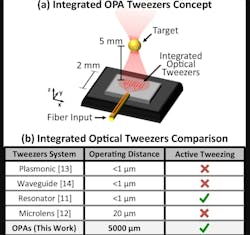Tractor Beam Uses Light to Attract Biological Particles
What you'll learn:
- Details of MIT's tractor-beam technology.
- How the chip-based design functions to trap and manipulate particles.
Engineers from MIT.nano have created a miniature, chip-based tractor beam, like those from Star Trek and Star Wars, that uses focused light to grab and manipulate biological cells. The breakthrough could help biologists and doctors study DNA, classify cells, and analyze diseases.
The silicon-photonics microchip features multiple optical traps that focus beams of light to isolate biological particles millimeters away from the chip and control their movements. Once the particles are trapped inside the light beam, traditional optical tweezers can move and manipulate them under glass coverslips, allowing them to remain in a sterile environment. The tweezers are scientific instruments that use a highly focused laser beam to hold and move microscopic and sub-microscopic objects.
The engineers tried the practice of using tweezers on polystyrene spheres. They managed to isolate cancer cells before using the tweezers to capture and manipulate their movements, making it the first time silicon-photonics-based optical tweezers were able to trap particles over a millimeter-scale distance (see figure).
"This work opens up new possibilities for chip-based optical tweezers by enabling trapping and tweezing of cells at much larger distances than previously demonstrated. It's exciting to think about the different applications that could be enabled by this technology," said Jelena Notaros, Professor of Electrical Engineering and Computer Science at MIT.
Tractor Beam’s Light Penetration
The light emitted from the tractor beam can penetrate barriers, such as glass, that protect samples from contamination, allowing for safer testing and treatment in a sterilized environment. The tractor beam also doesn't need to be on the same surface as the optical traps to be effective, as an integrated optical phased array (IOPA) can trap those cells from a distance.
With the tractor beam's precision and its ability to penetrate glass, the engineers feel optimistic about testing their work in a natural setting, as opposed to a synthetic environment. They will be able to work in less stressful settings that are already sterile.
Because of the microchip's compactness and the tractor beam's ability to reach distances, the engineers can place an entire lab system on a single chip, which reduces overhead and lowers the barrier needed for additional work or expansion. The engineers' breakthrough in tractor-beam technology will enable researchers and medical professionals to gain increased information about those biological particles and perhaps improve gene therapy in the future.
About the Author
Cabe Atwell
Technology Editor, Electronic Design
Cabe is a Technology Editor for Electronic Design.
Engineer, Machinist, Maker, Writer. A graduate Electrical Engineer actively plying his expertise in the industry and at his company, Gunhead. When not designing/building, he creates a steady torrent of projects and content in the media world. Many of his projects and articles are online at element14 & SolidSmack, industry-focused work at EETimes & EDN, and offbeat articles at Make Magazine. Currently, you can find him hosting webinars and contributing to Electronic Design and Machine Design.
Cabe is an electrical engineer, design consultant and author with 25 years’ experience. His most recent book is “Essential 555 IC: Design, Configure, and Create Clever Circuits”
Cabe writes the Engineering on Friday blog on Electronic Design.



